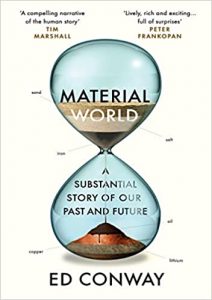I was lucky enough to get to read Ed Conway’s Material World, out on 15 June, in an advance proof copy. It’s an absolutely terrific book. There are six parts, covering six substances fundamental to the economy and modern life: sand, salt, iron, copper, oil and lithium. The component chapters cover the mining/making, the chemical processes, the experience of working to produce these fundamental materials, and the supply chains of which they form the anchors. And the book covers not only the economic issues but also the increasingly important geopolitical ones. It must have been hugely interesting to write, involving travel around the world, from deep, dark mines to chip fabs in Taiwan. (The author photo is very cool too – Ed in front of a giant digger at a mine.)
As someone whose first book was called The Weightless World, about the increasing intangibility of value added, I’m the first to agree about the importance of the material basis of society. While we might value more the ideas and services (the weightless parts), such that the ratio of GDP to the weight or mass of the economy has been increasing for some decades, the material is nevertheless fundamental.
Indeed, increasingly so. In the second half of the 20th century, natural and mineral resources seemed boundless, while produced capital and human capital (or ideas) were the binding constraints on economic growth. In the first half of the 21st century, that has flipped. Computation is all but free, whereas nature – including minerals – sets the binding constraints.
Anyway, Material World is highly recommended.

